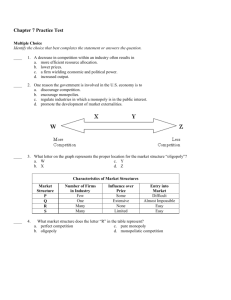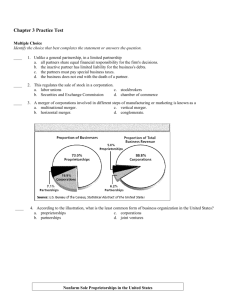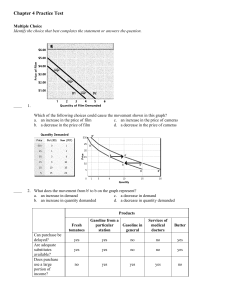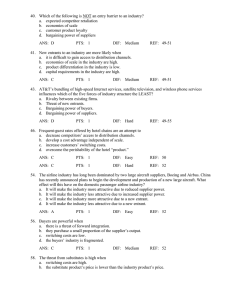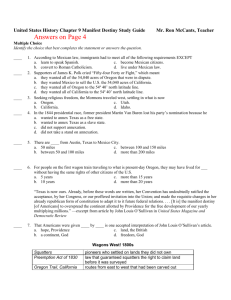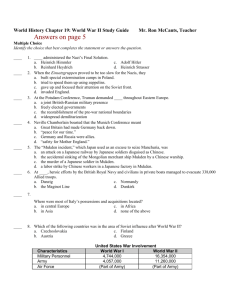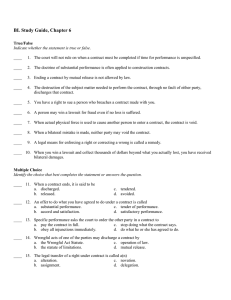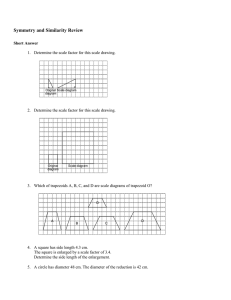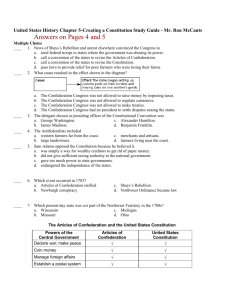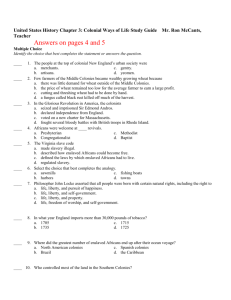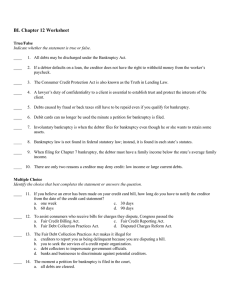Chapter 9 Practice Test
advertisement
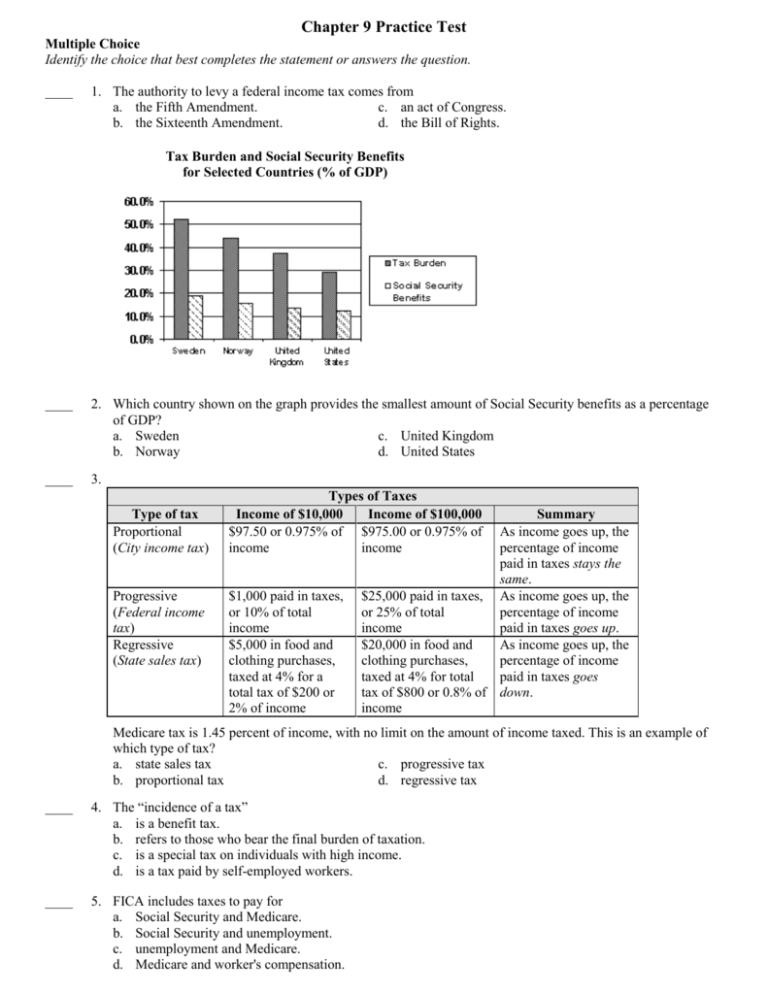
Chapter 9 Practice Test Multiple Choice Identify the choice that best completes the statement or answers the question. ____ 1. The authority to levy a federal income tax comes from a. the Fifth Amendment. c. an act of Congress. b. the Sixteenth Amendment. d. the Bill of Rights. Tax Burden and Social Security Benefits for Selected Countries (% of GDP) ____ 2. Which country shown on the graph provides the smallest amount of Social Security benefits as a percentage of GDP? a. Sweden c. United Kingdom b. Norway d. United States ____ 3. Type of tax Proportional (City income tax) Progressive (Federal income tax) Regressive (State sales tax) Types of Taxes Income of $10,000 Income of $100,000 $97.50 or 0.975% of $975.00 or 0.975% of income income $1,000 paid in taxes, or 10% of total income $5,000 in food and clothing purchases, taxed at 4% for a total tax of $200 or 2% of income Summary As income goes up, the percentage of income paid in taxes stays the same. $25,000 paid in taxes, As income goes up, the or 25% of total percentage of income income paid in taxes goes up. $20,000 in food and As income goes up, the clothing purchases, percentage of income taxed at 4% for total paid in taxes goes tax of $800 or 0.8% of down. income Medicare tax is 1.45 percent of income, with no limit on the amount of income taxed. This is an example of which type of tax? a. state sales tax c. progressive tax b. proportional tax d. regressive tax ____ 4. The “incidence of a tax” a. is a benefit tax. b. refers to those who bear the final burden of taxation. c. is a special tax on individuals with high income. d. is a tax paid by self-employed workers. ____ 5. FICA includes taxes to pay for a. Social Security and Medicare. b. Social Security and unemployment. c. unemployment and Medicare. d. Medicare and worker's compensation. ____ 6. The Taxpayer Relief Act of 1997 a. increased capital gains taxes. b. eliminated tax credits for families with children. c. changed marginal tax brackets to favor families. d. did little to benefit wage earners in the lowest 20 percent. ____ 7. Based on the graph, the total government receipts per capita for 2001 were a. 30 times greater than in 1962. c. 30 times greater than in 1974. b. 3 times greater than in 1962. d. 3 times greater than in 1974. ____ 8. Based on the chart, what source of federal government revenue increased the most from 1956 to 2004? a. social insurance taxes c. corporate income taxes b. excise taxes d. individual income taxes ____ 9. In panel B of the graph, how much of the cost of the tax did the producer pass on to the consumer? a. 90 cents c. $15.90 b. 10 cents d. $15.00 ____ 10. Tax Table for Single Individuals—2002 If the amount on Form 1040, line 39, is over... $0 $6,000 $27,050 $65,550 $136,750 $297,300 but not over... enter on Form 1040, line 40 $6,000 ----------$27,050 $600 $65,550 $3,652 $136,750 $14,240 $297,300 $35,956 -----------$92,951 + + + + + of the amount over... 10.0% $0 14.0% $6,000 27.0% $27,050 30.0% $65,550 35.0% $136,750 38.6% $297,300 Source: Schedule X, IRS Individual Tax Table. What type of tax does the tax table in the illustration represent? a. flat c. regressive b. progressive d. proportional ____ 11. Iowa residents can take solace in knowing that they’ll likely help the state with its budget crunch if President Bush cuts federal taxes. Iowa’s softening economy has left state government revenue stagnant, a problem caused by a lack of spending by Iowans. Sales-tax receipts have barely bumped up from last year, and it’s coming back to hit the state budget. In Iowa, residents get to deduct their federal income taxes from their state income taxes. So if the federal government saves Iowans $1 billion in income taxes, that’s $1 billion that the state will get to tax. Source: “Federal Tax Cut Could Bolster State Revenues,” The Omaha World-Herald, February 9, 2001. According to the passage, how will a cut in federal income taxes help the Iowa state budget crunch? a. The state can tax more of residents’ income. b. The federal government will grant more money for state programs. c. Iowans will have more money to donate to state projects. d. Iowans will be able to deduct more income from their state taxes. ____ 12. Summarize what the cartoonist is saying in this cartoon. a. Taxes are so high that they are reducing people to poverty. b. The Internal Revenue Service is not treating people fairly. c. The Internal Revenue Service is insensitive to the needs of the poor. d. People should not have to pay taxes. Chapter 9 Practice Test Answer Section 1. ANS: REF: 2. ANS: REF: 3. ANS: REF: 4. ANS: REF: 5. ANS: REF: 6. ANS: REF: 7. ANS: REF: 8. ANS: REF: 9. ANS: REF: 10. ANS: REF: 11. ANS: REF: 12. ANS: REF: B PTS: 1 DIF: Average Learn more about this question in Economics Principles and Practices, page 238. D PTS: 1 DIF: Easy Learn more about this question in Economics Principles and Practices, pages 239-240. B PTS: 1 DIF: Average Learn more about this question in Economics Principles and Practices, pages 235-236. B PTS: 1 DIF: Average Learn more about this question in Economics Principles and Practices, page 231. A PTS: 1 DIF: Average Learn more about this question in Economics Principles and Practices, page 239. D PTS: 1 DIF: Challenging Learn more about this question in Economics Principles and Practices, page 250. B PTS: 1 DIF: Average Learn more about this question in Economics Principles and Practices, page 250. A PTS: 1 DIF: Average Learn more about this question in Economics Principles and Practices, pages 239-240 A PTS: 1 DIF: Average Learn more about this question in Economics Principles and Practices, page 231. B PTS: 1 DIF: Average Learn more about this question in Economics Principles and Practices, pages 235-236. A PTS: 1 DIF: Easy Learn more about this question in Economics Principles and Practices, pages 250-251. A PTS: 1 DIF: Average Learn more about this question in Economics Principles and Practices, pages 249-251.



